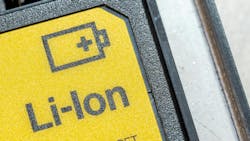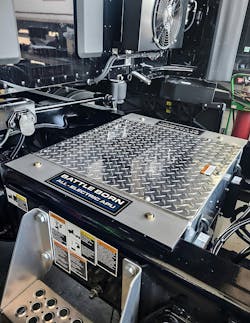Lithium batteries 101: What to know and how to service them
Check out our other recent charging-related content:
Compared to AGM and lead-acid batteries, lithium batteries are relatively new in the vehicle space, and there are several types vying for dominance—from lithium-ion (Li-ion), found in many of your cordless power tools and electric vehicles, to newer versions with a lithium iron phosphate (LiFePO4) cathode, which are lighter and lasts longer. And more are coming all the time, such as lithium-sulfur, which Stellantis says woll delivers higher power at a lower cost compared to traditional Li-ion.
With the list of lithium batteries available on the market expanding rapidly, knowing the key differences between these variations and how to service them is going to be an increasingly important skill.
What kinds of lithium batteries are available?
The increasing variety of lithium-ion battery types can be a bit problematic when it comes to service since all lithium batteries don’t have the same voltage and require different charging energy. To make matters worse, lithium batteries are very sensitive to over-voltage conditions, which can often result in bad outcomes.
Different lithium battery types are referred to as different lithium chemistries, which include nickel manganese cobalt (NCM), lithium cobalt oxide (LiCoO2), lithium-sulfur (Li-S), LiFePO4/LFP, and many others. Along with the different chemistries, there are different configurations in terms of cell structure, leading to a common warning, “All lithium batteries are not created equal.”
It is critical to make sure that any charger you are using to charge any lithium battery is properly mated to the specific lithium battery that you are servicing, as all lithium batteries are sensitive to voltage and can be dangerous if exposed to excessive voltage. So, check before you service your lithium battery–know the type of battery it is and that your equipment is compatible with it.
The LiFePO4 battery
LiFePO4 batteries are a type of lithium-ion battery known for their stability as compared to other lithium battery types, including other lithium-ion batteries. This stability means that they can be used in a wide variety of applications with a high degree of relative safety.
Here are some additional features:
- Longer cycle life than other lithium battery types and lead acid batteries
- Don't contain heavy metals, such as cobalt, which reduces their toxicity levels
- Lower energy density than other lithium chemistries
For now, they offer the best combination of safety and performance from an OE perspective, as evidenced by their overwhelming dominance in vehicle and transportation applications.
These batteries are used in a variety of passenger vehicle applications, like the BMW M-Series and Tesla Model S and X, thanks to their light weight and long cycle life. When it comes to commercial vehicles, they are most often found in APU applications, like the Dragonfly Energy Battle Born All-Electric Auxiliary Power Unit.
Read more: Dragonfly adds battery monitoring, alerts to Battle Born APU batteries
LiFePO4 charging: Things to watch for
Proper BMS management
A quality charger will play nice with the BMS (battery management system) used in these batteries. The BMS is like the battery’s brain. It monitors the battery and protects it from unsafe conditions.
2-stage charging: Constant current followed by constant voltage
This is the charging routine specified by virtually every LiFePO4 battery manufacturer. It is critical that charging voltage never exceeds 3.65V per cell. A quality charger will adhere to all of these requirements.
Temperature compensation
This feature is beneficial for all battery types serviced but is particularly necessary for beneficial charging of LiFePO4 batteries. Essentially, this feature adjusts the charge parameters based on temperature, ensuring that each charging instance gives the battery exactly what it needs.
Low-temperature safeties
LiFePO4 batteries shouldn’t be charged if their temperature is below 32 degrees F (0 degrees C). Some batteries have a BMS that will allow charging energy to flow at temperatures below 32 degrees F, but the general consensus is that charging a LiFePO4 battery that is below 32 degrees F is detrimental to long-term battery health
Managing deep discharge and avoiding severe discharge
Although they are much better at deep cycling than lead acid batteries and can discharge to a 100 percent discharge state, care must be taken when the battery is deeply discharged. Severe discharge is likely to trigger BMS protections, which can be detrimental to battery health and even cause the battery to reach a state where it cannot be recovered.
As the North American market for LiFePO4 lithium batteries grows, technicians will begin to encounter them in the shop, so it's important to know how to properly service them.
If you are addressing a vehicle or piece of equipment that requires a jump-start, you can use any voltage-compatible jump starter. By voltage-compatible, we mean, if it’s installed into a 12V system, use a 12V jump starter, if it’s installed in a 24V system, use a 24V jump starter, etc. Once you have confirmed that you have properly matched the battery/system voltage, you can use any type of jump starter, whether it’s powered by a traditional AGM battery, a lithium battery or an ultracapacitor power source. When you’re jump-starting, you are making a DC-DC connection and simply augmenting the disabled battery. Since everything is in the correct voltage window, no harm will come from using a lead acid jump starter on a system with a lithium starting battery and vice versa.
However, the same can’t be said for charging. The difference here is that a charger delivers energy to a battery and LiFePO4 batteries require their energy delivery in a specific manner. The charging requirements for a LiFePO4 battery are different from those of other lithium batteries and also different from those of lead-acid batteries. LiFePO4 batteries have a fully charged voltage per cell that should never be exceeded. Doing so could result in LiFePO4 battery deterioration (at best) or complete battery destruction (at worst).
The key is to always charge LiFePO4 batteries with a battery charger specifically designed to charge and maintain LiFePO4 lithium batteries. Companies like PRO-LOGIX are good options for battery chargers and maintainers as a quality LiFePO4-specific charger is going to precisely control its voltage output and protect the battery from unsafe charging conditions.
With a range of products that have specific, dedicated charging routines for LiFePO4 batteries, along with the ability to properly charge various lead acid batteries, from flooded to AGM and spiral wound, PRO-LOGIX can provide specialized service coverage for a wide range of battery types, helping you ensure that the voltage output is precise.
Check out the full article and more in-depth service guidelines on our affiliate site VehicleServicePros.com.
About the Author

Jim O' Hara
Clore Automotive
Jim O'Hara has over 15 years experience in the Tool and Equipment industry, including 10+ years at Clore Automotive. At Clore, he heads up the marketing team and is directly involved in the development of new products and enhancements of existing products.

